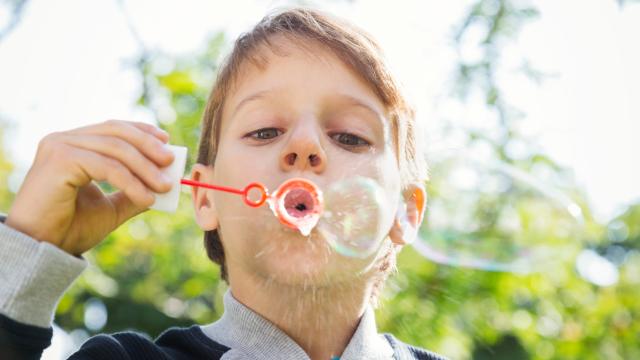Have you ever come across a street entertainer who starts blowing a spectacle bubbles at the park or a festival, and all the kids immediately jump and squeal and lose their minds? And then you try to recreate the same scene at home for your children … and fall short. Don’t worry — all is not doomed. You just need to get science on your side.
It’s all about the breath
The component that most determines a bubble’s formation isn’t the wand, or even the solution, but the wind speed. As Popular Science shares, mathematicians have recently discovered the optimal formula for bubble blowing:
U = √(5.6 x gamma / rho * R), where U is the wind speed, gamma is the surface tension coefficient between the two fluids involved, rho is the density of fluid you’re blowing, and R is the radius of the bubble wand.
If your response to that is like mine—a blank stare—you can think about it like this: For a bubble wand with a radius of 1 centimeter, the optimal wind speed is about 13km per hour. (For context, as PopSci notes, the average human sneeze is about 63km per hour.) Of course, you can’t actually measure how fast you’re blowing without fancy tools, so just try blowing at different speeds to see what works.
But the solution matters, too
For strong bubbles with a pretty rainbow sheen, use a liquid dish soap. These types of soaps are detergents, meaning that they contain surfactants, and surfactants are important because they reduce the surface tension in water. Less surface tension allows for a more even layer of water, thus making your bubble harder to burst. Adding a stabilizer such as white sugar or corn syrup adds strength, too.
Professional bubble artists like Melody Yang adjust their solutions based on the environment they’re in—dry and hot atmospheres make bubbles pop faster, as does thin air in high elevations.
Here’s a tried-and-true formula used in the exhibits at San Francisco’s Exploratorium:
-
2/3 cup dishwashing soap
-
3.8L water
-
2 to 3 tablespoons of glycerine (available at the pharmacy or chemical supply house.)
Experiment with different wands
The wand is the least critical component of bubble making—you can use the one that came in your bubble solution, string such as baker’s twine to make enormous bubbles, a pipe cleaner that’s formed into a circle, or your forefinger and thumb shaped into an O. Watch Yang demonstrate the finger technique here:
Soak your entire hand in the solution, make an “OK” sign, flip it on its side and start blowing. After you’ve made a bubble, she says, “What you have to do is close that hole and capture that air.” Try it, and watch your kids flip out. Thanks, science!

Comments
One response to “There’s A Mathematical Formula For Blowing A Perfect Bubble”